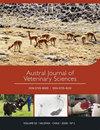利用阈值模型对智利Los Ríos地区牧场下第一胎奶牛亚临床乳腺炎的遗传参数进行估计
IF 0.8
4区 农林科学
Q3 VETERINARY SCIENCES
引用次数: 0
摘要
. 体细胞计数(SCC)是评估乳腺健康状况的一种间接测量方法。这一特征提供了关于每个季度乳腺组织炎症严重程度的信息。来自农场牛奶储存桶的牛奶样本含有100,000至200,000细胞/mL被认为是可疑的,而超过200,000细胞/mL的SCC是亚临床乳腺炎的指征。当农民的散装罐样品达到300,000细胞/毫升SCC水平时,智利乳制品加工商会对农民处以罚款。本研究的目的是量化奶牛达到300,000细胞/mL阈值的倾向性的加性遗传成分。分析了智利南部Los Ríos地区15个商业奶牛场10,528头泌乳奶牛的最高SCC测试日记录的数据集。每头奶牛达到300,000 SCC阈值的未知连续潜在易感性被建模为由牛群、年份和产犊季节组成的当代群体的函数,奶牛未知潜在易感性值对其日产奶量(MY)的回归系数以及加性动物遗传效应。使用贝叶斯推理和吉布斯抽样来估计加性和残差方差。平均每日MY和SCC分别为17.84±5.25 kg和125,327±236,297 cell/mL。估计遗传力为0.03 ~ 0.22,平均值为0.10±0.03。由此可见,易感性达到300,000 SCC阈值的遗传变异性可用于提高对亚临床乳腺炎的抵抗力。本文章由计算机程序翻译,如有差异,请以英文原文为准。
Estimation of genetic parameters for subclinical mastitis using a threshold model in first parity dairy cows under pasture-based systems of Los Ríos Region in Chile
. Somatic cell count (SCC) is an indirect measurement to estimate mammary gland health status. This trait provides information regarding the severity of the mammary tissue inflammation in each quarter. Milk samples coming from the farm milk storage vat containing 100,000 to 200,000 cell/mL are considered suspicious, while SCC over 200,000 cell/mL is an indication of subclinical mastitis. Chilean dairy processors penalise farmers monetarily when their bulk tank samples reach levels of 300,000 cell/ mL SCC. The objective of this study was to quantify the additive genetic component of the liability of cows to reach the 300,000 cell/mL threshold. A data set containing the highest SCC test-day record of 10,528 first lactation cows from 15 commercial dairy farms of Los Ríos Region in southern Chile was analysed. The unknown continuous underlying susceptibility of each cow to reach the 300,000 SCC threshold was modelled as a function of a contemporary group formed by the herd, year, and calving season, the regression coefficient of the unknown underlying susceptibility value of a cow on her daily milk yield (MY) and the additive animal genetic effect. Bayesian inference and Gibbs sampling were used to estimate additive and residual variances. The average daily MY and SCC were 17.84±5.25 kg and 125,327±236,297 cell/mL, respectively. The estimated heritability varied from 0.03 to 0.22 and the average was 0.10±0.03. It is concluded that the genetic variability for the susceptibility to reach the 300,000 SCC threshold could be exploited to improve resistance to subclinical mastitis.
求助全文
通过发布文献求助,成功后即可免费获取论文全文。
去求助
来源期刊

Austral Journal of Veterinary Sciences
Veterinary-General Veterinary
CiteScore
1.60
自引率
0.00%
发文量
18
期刊介绍:
Austral Journal of Veterinary Sciences (formerly Archivos de Medicina Veterinaria) publishes original scientific contributions in English, containing the latest developments and discoveries in veterinary sciences. The journal covers topics such as animal health and production, preventive medicine, zoonosis, pharmacology and therapeutics, methods of diagnosis, and other areas related to the veterinary field.
Austral Journal of Veterinary Sciences aims to divulge information about advances in veterinary medicine among universities, research centres, industries, government agencies, biologists, agronomists and veterinarians.
 求助内容:
求助内容: 应助结果提醒方式:
应助结果提醒方式:


